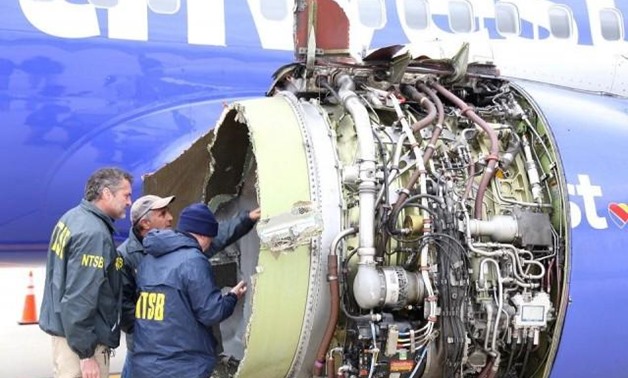
Southwest engine explosion began when fan blade broke -NTSB - Reuters
19 April 2018: Federal air safety officials investigating why the engine of a Southwest Airlines jet blew apart, killing a passenger after shattering a plane window, said on Wednesday that the incident began when a fan blade already suffering metal fatigue snapped off in mid-flight.
National Transportation Safety Board Chairman Robert Sumwalt told a news conference that he could not yet say if the incident, the first deadly airline accident in the United States since 2009, pointed to a fleet-wide issue in the Boeing 737-700.
"We want to very carefully understand what was the result of this problem, and as I mentioned a few minutes ago, I’m very concerned about this particular event," Sumwalt said at the news conference at the Philadelphia airport. "To be able to extrapolate that to the entire fleet, I’m not willing to do that right now.”
The CFM56 engine exploded over Pennsylvania about 20 minutes after Dallas-bound Southwest Flight 1380 left New York's LaGuardia Airport with 149 people on board, sending pieces of shrapnel into the plane.
Bank executive Jennifer Riordan, 43, was killed when she was partially pulled through a shattered window next to her seat in row 14 as the cabin suffered rapid decompression. Fellow passengers were able to pull her back inside but she died of her injuries later on Tuesday.
Southwest crews were inspecting similar engines the airline had in service, focusing on the 400 to 600 oldest of the CFM56 engines, made by a partnership of France's Safran and General Electric, according to a person with knowledge of the situation. It was the second time that style of engine had failed on a Southwest jet in the past two years, prompting airlines around the world to step up inspections.
A National Transportation Safety Board inspection crew was also combing over the Boeing 737-700 for signs of what caused the engine to explode.
Sumwalt said the fan blade, after suffering metal fatigue where it attached to the engine hub, suffered a second fracture about halfway along its length. Pieces of the plane were found in rural Pennsylvania by investigators who tracked them on radar. The metal fatigue would not have been observable by looking at the engine from the outside, Sumwalt said.
According to Sumwalt, the jet was traveling at 190 miles per hour when it made an emergency landing at Philadelphia International Airport, much faster than the typical 155-mile-per-hour touchdown.
Passengers described scenes of panic as a piece of shrapnel from the engine shattered a window on the aircraft, almost sucking Riordan out.
"The window had broken and the negative pressure had pulled her outside the plane partially," Peggy Phillips, a registered nurse who was on the plane, told WFAA-TV in Dallas. "Two wonderful men ... they managed to get her back inside the plane, and we laid her down and we started CPR."
Riordan was a Wells Fargo banking executive and well-known community volunteer from Albuquerque, New Mexico, the company said.
"MY LAST FEW MOMENTS"
Videos posted on social media showed passengers grabbing for oxygen masks and screaming as the plane, piloted by 56-year-old Tammie Jo Shults, a former fighter pilot for the U.S. Navy, prepared for the descent into Philadelphia.
"All I could think of in that moment was, I need to communicate with my loved ones," passenger Marty Martinez told ABC's "Good Morning America" on Wednesday. During the incident, he logged on to the plane's in-flight Wi-Fi to send messages to his family.
"I thought, these are my last few moments on Earth and I want people to know what happened," said Martinez, who live-streamed on Facebook images of passengers in oxygen masks as the plane made a bumpy descent into Philadelphia.
Southwest Airlines experienced an unrelated safety incident early on Wednesday when a Phoenix-bound flight was forced to land at the Nashville airport shortly after takeoff because of bird strike.
The airline expected to wrap up its inspection of the engines it was targeting in about 30 days.
The GE-Safran partnership that built the engine said it was sending about 40 technicians to help with Southwest's inspections.
Pieces of the engine including its cowling - the smooth metal exterior that covers its inner workings - were found about 60 miles (97 km) from Philadelphia airport, Sumwalt said. The investigation could take 12 to 15 months to complete.
In August 2016, a Southwest flight made a safe emergency landing in Pensacola, Florida, after a fan blade separated from the same type of engine and debris ripped a hole above the left wing. That incident prompted the U.S. Federal Aviation Administration to propose last year that similar fan blades undergo ultrasonic inspections and be replaced if they failed.

Comments
Leave a Comment